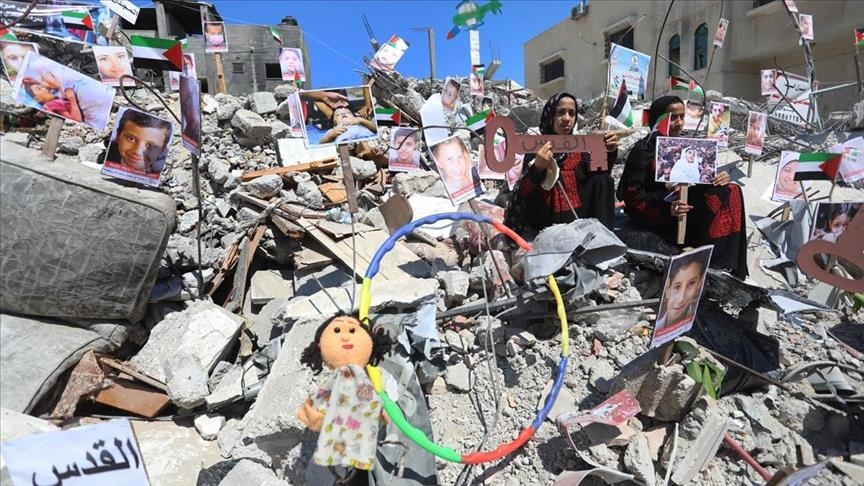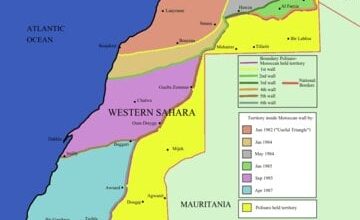
Devastation And Genocide In Gaza.
A Report from Gaza.
By Ahlam Hammad
April 19.2024
Six months elapsed, and the Israeli war on the Gaza Strip entered its seventh month; the killing and destruction machine does not stop committing the most heinous and violent war crimes against people, trees, and stones, and changes with it the shape of the Gaza Strip in terms of demographic and urban structure.
In this report, Ultra Palestine focuses on the impact of the war on the various aspects of life in an initial outcome for half a year, based on data issued by official Palestinian and international organizations since the outbreak of the Israeli war on Gaza after the attack of the seventh of October last year, which the Qassam Brigades called “the flood of Al-Aqsa,” the “blood and destruction counter” did not stop. The occupation forces practiced types of crimes against 2.2 million Palestinians in this small sector and forced 85 Percent of them to be displaced and moved out of their houses and towns. Over a million of them have been crammed into Rafah amid transcendent threats of invasion and a massive ground operation.
As published by the Government Media Office, the occupation committed 2,922 massacres, killing 39,975 martyrs and missing persons, including 14,500 children, 9,560 women, 484 medical staff, 65 civil defense, and 140 journalists.
According to the latest data from the Ministry of Health in Gaza, 75,886 Palestinians have been injured since the outbreak of the war. According to state media and health, 73 percent of the victims are children and women, while 17,000 children live without parents or without one of them.
In terms of material losses, it is difficult to monitor them accurately due to the difficulty of movement of local and international organizations and bodies in the field in light of the escalation of the war and the continued separation of the occupation in the north of the most destroyed Gaza Strip from the rest of the Gaza Strip areas in the southern Gaza Valley.
In the latest data on the size of these losses, the World Bank and the United Nations estimated in a joint report assessing the damage to critical infrastructure between October and the end of January at about $ 18.5 billion, equivalent to 97 percent of the gross domestic product of the West Bank and Gaza Strip combined in 2022.
These losses include the cost of damaged infrastructure such as residential homes, water, sanitation, energy, roads and transportation, communications and technology, municipal services, industry and agriculture, and other sectors of life. At the same time, the international report does not cover the repercussions of the war in the last two months.
war of revenge
Palestinian officials and civil bodies estimate the value of the material losses inflicted on the joints of life and its various sectors at more than $ 30 billion. Ismail al-Thawabta, director of the government media office, said that the occupation targeted the Gaza Strip with about 70,000 tons of explosives in the implementation of the systematic policy of killing and destruction.
In December last year, the media office issued the first estimate of about $12 billion in direct material losses. Still, Al-Thawabta confirms that the numbers have doubled and that the current losses exceed $30 billion. The head of the International Organization for the Defense of the Rights of the Palestinian People (Hashad), Salah Abdel Ati, agrees with him and confirms that the war losses are frightening and exceed these figures.
According to preliminary figures from the Commission, the war has destroyed 70% of citizens’ homes and properties, especially in the northern half of the Gaza Strip (Gaza and northern Gaza governorates). Abdel Ati asserts that the occupation pursued a policy of revenge aimed at shedding more blood and expanding the circle of destruction.
This bloody and destructive policy, in Abdel’s opinion, falls within the context of the occupation’s plans aimed at making Gaza an unviable area and pushing the people of Gaza to emigrate after they despair of living amid the massive destruction of their residential homes and all their public and private capabilities, including schools, hospitals, mosques, and infrastructure.
Abdel Ati believes that the magnitude of the disaster will exceed all estimates. Gaza’s losses will not stop at direct destruction, as there are essential and influential indirect losses that have serious negative consequences resulting from the collapse of the labor sector, and 90 percent of Gaza’s workers lost their jobs and source of livelihood, which will worsen and devastate the living reality.
In terms of numbers, the Israeli occupation forces completely destroyed more than 70,000 housing units. They caused severe and moderate damage to about 600,000 others, equivalent to 70% of the housing units in the Gaza Strip, in addition to extensive destruction in hotels and parks.
In the government health sector, the occupation targeted 159 health institutions, resulting in the removal of 32 hospitals and 53 health centers from service, the destruction of more than 126 ambulances, and the destruction of 171 government headquarters of ministries, institutions, and security and civilian headquarters.
Mosques, churches, and historical sites were not spared from the systematic Israeli destruction, with 229 mosques wholly destroyed, 297 mosques partially destroyed, 3 churches destroyed, and about 200 archaeological sites and historic buildings destroyed.
During the Israeli ground incursion, airstrikes, artillery shelling, and landslide destroyed thousands of industrial and commercial facilities, including factories, banks, shops, bakeries, farms, warehouses, service offices, fishing companies, and boats. Local authorities estimate that half of the agricultural area in the Strip, especially in Gaza City and its north, has been completely destroyed. According to the head of the International Organization for the Defense of Palestinian People’s Rights (Hashad), this destruction would raise the poverty rate in the Gaza Strip to 90 percent, with a massive rise in the unemployment rate. Hundreds of thousands of workers are out of work.
The Director General of the Government Information Office, Ismail Al-Thawabta, said that the occupation pursued a policy of concentrated destruction of educational facilities and institutions, which resulted in the total destruction of 100 schools and universities and severe damage to more than 305 others.
Al-Thawabta agrees with Abdel Ati that this destructive policy is systematic and intends to comprehensively and extensively destroy all aspects of life, including markets and shops, streets and cars, electricity, communications, and internet networks, with the explicit goal of making Gaza unviable, and push its people towards emigration.
Published in Arabic in sawtoroba and translated by Abou Zeid.





